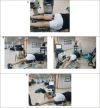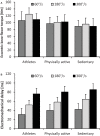Effects of Neuromuscular Fatigue on Eccentric Strength and Electromechanical Delay of the Knee Flexors: The Role of Training Status
- PMID: 31293448
- PMCID: PMC6606703
- DOI: 10.3389/fphys.2019.00782
Effects of Neuromuscular Fatigue on Eccentric Strength and Electromechanical Delay of the Knee Flexors: The Role of Training Status
Abstract
Purpose: To examine the effects of fatiguing isometric contractions on maximal eccentric strength and electromechanical delay (EMD) of the knee flexors in healthy young adults of different training status. Methods: Seventy-five male participants (27.7 ± 5.0 years) were enrolled in this study and allocated to three experimental groups according to their training status: athletes (ATH, n = 25), physically active adults (ACT, n = 25), and sedentary participants (SED, n = 25). The fatigue protocol comprised intermittent isometric knee flexions (6-s contraction, 4-s rest) at 60% of the maximum voluntary contraction until failure. Pre- and post-fatigue, maximal eccentric knee flexor strength and EMDs of the biceps femoris, semimembranosus, and semitendinosus muscles were assessed during maximal eccentric knee flexor actions at 60, 180, and 300°/s angular velocity. An analysis of covariance was computed with baseline (unfatigued) data included as a covariate. Results: Significant and large-sized main effects of group (p ≤ 0.017, 0.87 ≤ d ≤ 3.69) and/or angular velocity (p < 0.001, d = 1.81) were observed. Post hoc tests indicated that regardless of angular velocity, maximal eccentric knee flexor strength was lower and EMD was longer in SED compared with ATH and ACT (p ≤ 0.025, 0.76 ≤ d ≤ 1.82) and in ACT compared with ATH (p = ≤0.025, 0.76 ≤ d ≤ 1.82). Additionally, EMD at post-test was significantly longer at 300°/s compared with 60 and 180°/s (p < 0.001, 2.95 ≤ d ≤ 4.64) and at 180°/s compared with 60°/s (p < 0.001, d = 2.56), irrespective of training status. Conclusion: The main outcomes revealed significantly higher maximal eccentric strength and shorter eccentric EMDs of knee flexors in individuals with higher training status (i.e., athletes) following fatiguing exercises. Therefore, higher training status is associated with better neuromuscular functioning (i.e., strength, EMD) of the hamstring muscles in fatigued condition. Future longitudinal studies are needed to substantiate the clinical relevance of these findings.
Keywords: hamstring muscles; injury risk; latency; muscle activation; physical fitness expertise.
Figures


Similar articles
-
Effects of High Velocity Elastic Band versus Heavy Resistance Training on Hamstring Strength, Activation, and Sprint Running Performance.J Sports Sci Med. 2017 Jun 1;16(2):239-246. eCollection 2017 Jun. J Sports Sci Med. 2017. PMID: 28630577 Free PMC article.
-
Drop punt kicking induces eccentric knee flexor weakness associated with reductions in hamstring electromyographic activity.J Sci Med Sport. 2017 Jun;20(6):595-599. doi: 10.1016/j.jsams.2016.09.006. Epub 2016 Sep 20. J Sci Med Sport. 2017. PMID: 28314618 Clinical Trial.
-
Analysis of the Hamstring Muscle Activation During two Injury Prevention Exercises.J Hum Kinet. 2017 Dec 28;60:29-37. doi: 10.1515/hukin-2017-0105. eCollection 2017 Dec. J Hum Kinet. 2017. PMID: 29339983 Free PMC article.
-
Is there a potential relationship between prior hamstring strain injury and increased risk for future anterior cruciate ligament injury?Arch Phys Med Rehabil. 2014 Feb;95(2):401-5. doi: 10.1016/j.apmr.2013.07.028. Epub 2013 Oct 9. Arch Phys Med Rehabil. 2014. PMID: 24121082 Review.
-
An Evidence-Based Framework for Strengthening Exercises to Prevent Hamstring Injury.Sports Med. 2018 Feb;48(2):251-267. doi: 10.1007/s40279-017-0796-x. Sports Med. 2018. PMID: 29116573 Review.
Cited by
-
Effect of Six-Week Speed Endurance Training on Peripheral Fatigue.Int J Environ Res Public Health. 2022 Aug 31;19(17):10841. doi: 10.3390/ijerph191710841. Int J Environ Res Public Health. 2022. PMID: 36078556 Free PMC article.
-
Effects of physical stress in alpine skiing on psychological, physiological, and biomechanical parameters: An individual approach.Front Sports Act Living. 2022 Oct 10;4:971137. doi: 10.3389/fspor.2022.971137. eCollection 2022. Front Sports Act Living. 2022. PMID: 36299402 Free PMC article.
-
Electromyographic activity in deadlift exercise and its variants. A systematic review.PLoS One. 2020 Feb 27;15(2):e0229507. doi: 10.1371/journal.pone.0229507. eCollection 2020. PLoS One. 2020. PMID: 32107499 Free PMC article.
-
Evaluation of the Lower Limb Muscles' Electromyographic Activity during the Leg Press Exercise and Its Variants: A Systematic Review.Int J Environ Res Public Health. 2020 Jun 27;17(13):4626. doi: 10.3390/ijerph17134626. Int J Environ Res Public Health. 2020. PMID: 32605065 Free PMC article.
-
Maximal isokinetic elbow and knee flexor-extensor strength measures in combat sports athletes: the role of movement velocity and limb side.BMC Sports Sci Med Rehabil. 2022 Mar 16;14(1):40. doi: 10.1186/s13102-022-00432-2. BMC Sports Sci Med Rehabil. 2022. PMID: 35296340 Free PMC article.
References
-
- Bell D. G., Jacobs I. (1986). Electro-mechanical response times and rate of force development in males and females. Med. Sci. Sports Exerc. 18, 31–36. PMID: - PubMed
LinkOut - more resources
Full Text Sources

